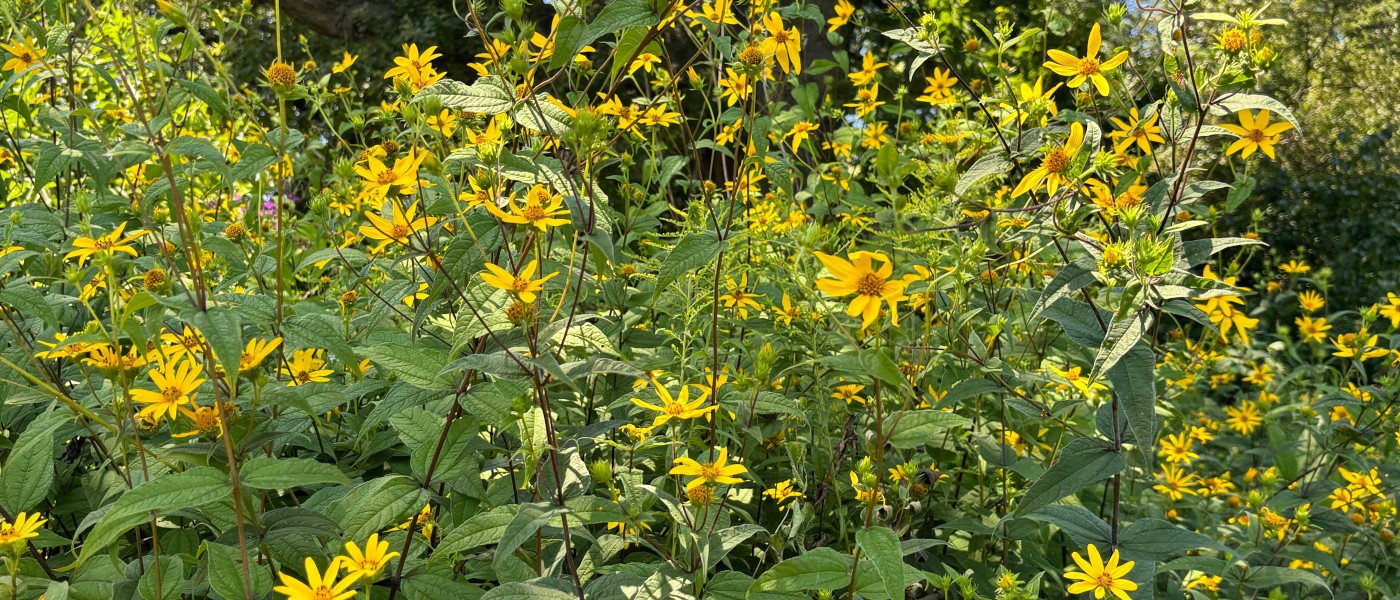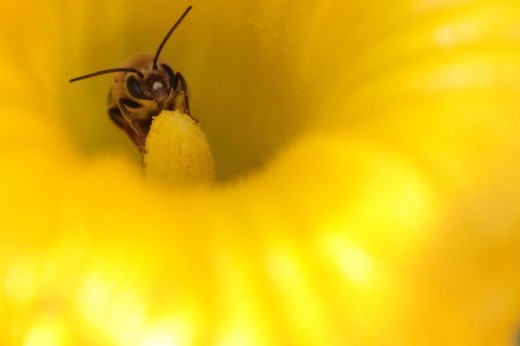A good interspecies romance really gets me buzzing. Both the artist and gardener in me delight in interactions that reveal a kindredness between creatures. So, in June, when BBG selected me as their artist in residence, I couldn’t wait to make a performance based on this year’s theme, Natural Attractions: A Plant-Pollinator Love Story.

July brought extreme heat to the Garden, and with it came swaying pink clouds of Joe-pye weed and the rhythmic staccato of sprinklers on foliage. I spent my days alternating between sweaty chats with gardeners and sweaty reading sessions with Derek Jarman’s Modern Nature. I read in the grass near Belle’s Brook, which was fringed with volunteer jewelweed—fitting complements to the astringent, soothing writing of a queer ancestor and artist-gardener.
In Modern Nature, Jarman records the saga of tending his garden at Prospect Cottage while meditating on his experience as a filmmaker, artist, and HIV+ man in the 1980s. Writing at the restless intersection of nature and culture, Jarman combines the timeline of one life and the profusion of timelines that occur in a garden, with its endless cycles of bloom and decay.
As I began writing a script for the performance, I noticed how the rhythms of gardening have shaped my own sense of time and place, and my relationships to other beings. Working as a gardener provides a seasonal framework for my artmaking. Plant-pollinator mutualisms reflect the messy dance of collaborating with others toward shared creative goals. Thinking about the history of horticulture and my place within that discourse provides a fraught set of questions to explore through art.
I’ve found that gardening and artmaking are twin practices, perennially present in my life, that enliven and complicate my search for community and connection.

In a dense city full of cramped apartments, where public and private life spills onto the streets, I feel thankful to have spent most of the last decade working outside: tending backyard gardens in Cobble Hill, weeding flower beds near the base of the Brooklyn Bridge, and gardening with tenants at New York Supportive Housing buildings in four different boroughs. Gardening ties a person to a specific landscape and its inhabitants. For me, it has also allowed me to meet queer folks I might not have encountered otherwise.
In April of 2018, I met Scott, a 61-year-old gay artist-gardener living in Washington Heights. Almost immediately, I recognized in him some bits of the person I hope to become. Scott is the kind of storyteller that makes you want to capture every word on tape. He is an artist whose medium is whimsy, and whose understanding of his role within a neighborhood is illustrated through his thoughtful cultivation of beauty.
I joined him in tending a haphazard patchwork of garden beds around his apartment building. Scott cares for the bits of soil the paving machines forgot. In a tiny hellstrip in the middle of Amsterdam Avenue, he planted a voluptuous lilac. In his backyard, he grows asparagus in an old tire stuffed with potting soil, balanced precariously atop an eight-foot-tall retaining wall. In his community garden bed, hops wind their way up a makeshift trellis made of trash pile finds, their curling tendrils seeming to brush the clouds above our heads.
For all his joy, Scott’s creative impulses have also been shaped by the devastation of the AIDS crisis. His garden is dotted with hand-painted signs and assemblages: a small disco ball, metal sculptures decorated with sea glass and feathers, a plastic giraffe wandering among four o’clocks and milkweeds. Treasures tossed out and reclaimed, combined to make memorials for friends who have passed. Scott’s garden, and his art, hold space for loss, even as they overflow with life.
Through artmaking and gardening, we can conjure something outside of reality as we know it.
In his essay “The Garden as Pharmacopoeia,” writer-gardener Jonny Bruce positions Derek Jarman’s Garden at Prospect Cottage “as a place of resistance and resilience, and also a site of profound grief.” I see that quality in the planted memorials behind Scott’s apartment. And for me, it points to the ways that both making art and gardening help us digest history and our place within it.
Jamaica Kincaid and Olivia Laing also write incisively about the mercurial practice of gardening as one that both mirrors history and constantly disrupts it. A process that can help us hold complexity when considering how power functions in relation to landscape. How colonialism need not dictate our interactions with place and other beings, even as it haunts them. How gardening helps us grieve. How it might help reshape the narratives that inevitably tie us to land, and to each other.
Cyclical and iterative, these practices each function as both an object (or a place) and an activity that shifts and grows as we do. Through artmaking and gardening, we can conjure something outside of reality as we know it, exploring possibilities beyond the crushing weight of oppression and control.

I like to think that Scott and I descend from a long line of artist-gardeners who have shown that these parallel practices can form a potent combination, reminiscent of the plant-pollinator mutualisms I’ve been researching.
That’s not to say that it’s always happily ever after. Jenny Blackwell, who has gardened at BBG for nearly a decade, told me about the ancient relationship between magnolias and their beetle pollinators. Beetles pre-date the existence of more celebrated pollinators like bees and butterflies, but they are clumsy, chewing holes in magnolia tepals and soiling otherwise glossy leaves with tiny piles of frass.
Magnolia flowers, for their part, seduce beetles with their musky scent, even trapping the beetles temporarily inside their blooms to ensure pollination. But for all their shenanigans, these two organisms have evolved in conversation with each other—and sustained one another—over millions of years.
I’ve been thinking about this connection as I move into rehearsals for the performance at BBG. The script I’ve written brings together horticulturists, visual artists, and performers to make something that, like a plant-pollinator relationship, buzzes with unhinged aliveness, even as it is finely tuned.
Many of us in the cast are performing as ourselves, and speaking from our own experiences and expertise. We’re making a play for Brooklyn Botanic Garden, and tussling with the complexities that all gardens hold: beautiful creation, habitual labor, and the strange webs that form and unravel as we participate in a cycle of life.



